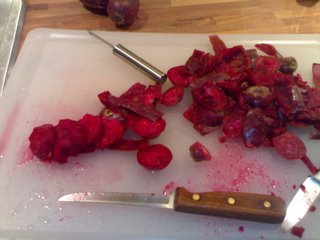
Well it’s been a busy summer here in the Southland, swimming lessons, traveling, trying not to listen to the news, it’s a wonder for when a guy can get any cooking done. By the way, the South Side was mentioned in the Sunday New York Times, last weekend. In an profile of John C. Reilly, the article stated that Reilly grew up in a “gritty South Side neighborhood…” in a “squat bungalow.” Once again the myth is perpetuated: Say you are from the South Side and folks start lookin to see if you have a gun stuck in your waistband. There must be some rule where folks from outside the Chicago are required to say “gritty” when saying the words “South Side.” I am sure that if, as the article states, Mr. Reilly’s father owned a commercial laundry service, and they lived in a bungalow near Marquette Park, Reilly’s youth may have been more accurately characterized as a “modest middleclass upbringing.” But that doesn’t sound very cool.
Continuing on this digressive diatribe regarding the Times (wait, you’ll see it comes full circle) I read over two articles today regarding Tacos. I’ll insert links for the articles, but I don’t know how long they will work, at a certain point the Times makes you pay to peak. The first article, The Taco Joint in Your Kitchen, by Mark Bittman, has only one valid worthwhile statement: In New York, a good taco is hard to find. True. When I lived in New York, good Latino (Mexican) food was very hard to find, we would travel to the ends of the Earth (New Jersey) in the hopes of finding something above mediocre.
But then the article goes on to state that Genuine Tacos can only be found in the Southwest or Mexico. False. Once again New Yorkeritis rears its ugly head; that’s the disease were the New Yorker (the inhabitant, not the magazine) believes that the only thing West of NYC is New Jersey and California. When I lived there I had it too. Chicago has some of the most beautiful, most delicious, most hardcore Mexican food to be had anywhere, and I missed it terribly when I lived out East. And what goes into a “Genuine Taco” in the little 3 inch corn tortillas supposedly only available in Cali and South of the Border? In my experience, meat. If you ask, and you can put up with the cook shaking his head, cheese. You get three on a plate surrounded by a little lettuce and tomato, and you eat them with a little salsa. Wash it down with a little horchata (no beer, its lunch time, and you are on the job) or if you are at Irazu on Milwaukee Ave., a Guayaba en Leche and there you go, genuine.
The second Article (just a related recipe) Recipe: Slow-Roasted Pork for Tacos, must be geared towards the apartment dweller in Murray Hill. The recipe calls for two pounds of pork shoulder; good luck finding that. Most shoulder roasts come packaged between five and eight pounds and rarely come boneless. And you should cook a full roast at a time anyway, pulled pork freezes really well and reconstitutes nicely in a skillet. The bigger piece of meat just takes more cook time. I wont go into the spices and prep, but regarding cooking and serving, the meat should be shredded and that means cooking to somewhere between 190F to 200F. Below 190 you’ll be slicing. The recipe says to cook until “very very tender, at least two hours” Just take its temp you will know when it is done. Anything above 160 and below 175 the meat is fully cooked, but you’ll be slicing a very chewy piece of meat.
And wait a minute, this recipe looks like a dumbed down version of Slow Roasted Achiote Pork, in Rick Bayless’ Mexico, One Plate at a Time. Why? Well that’s what was in the kitchen last weekend.

Last weekend was the block party, the time of the year when the neighbors get together eat, watch movies outside and generally run amok until two or three in the morning.
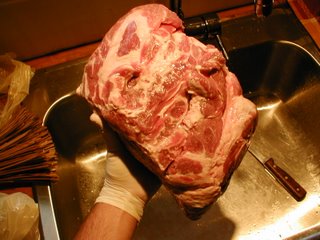
The past couple of years I have done a brisket bbq but this time I bought a pork butt for pulled pork ( about 8-1/2 pound bone in). However the neighbors wanted a Mexican theme. So how about pulled pork tacos? 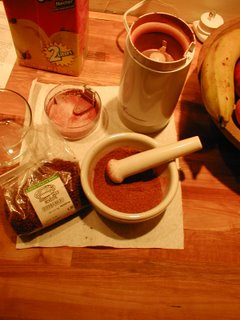

Rick’s recipe called for blending achiote seeds (I learned they are also called annatto seeds, which made them easier to find) black pepper, cumin, Mexican oregano, cinnamon and cloves, stir that into lime juice and orange juice, and throw in a handful of cloves. Put your butt into the marinade and let it soak overnight.
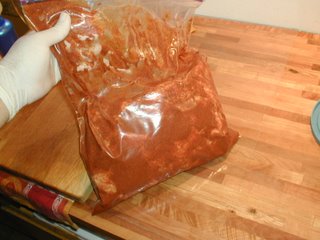
Now the recipe calls for cutting the roast into several slices and wrapping them in Banana leaves. Now as much as I like the idea of pork steaming in banana leaves over the pit fire, I lent my bone saw to a buddy to trim his mulberry tree, so the roast stays whole. I started the roast at 8 am figuring 6-8 hours to finish. However at 7 am I realized I was short charcoal, so a I built a smaller than usual fire. Instead of a 275F smoking temp I was at 225F. So at 5PM(the party already started) I pulled the pork off at 185F, 15 degrees short of the goal.
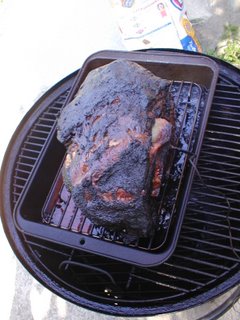
Most of it shredded but some had to be sliced. Again to hammer home the point, on tough cuts of meat (pork shoulder, Boston butt, beef brisket beef plate) you cook them low and slow to allow the fat to render (“self basting” in the Taco article) and the connective tissue to break down. The results is moist and tender meat. Most of the rendering and tissue break occurs past 160 F, so you got to keep on going.

Anyway Taco time. The night before I also sliced some red onion and marinated it in 2 parts lime juice (limes were twelve for a dollar) and 1 part orange juice. To build a taco: Tortilla, meat, onion.
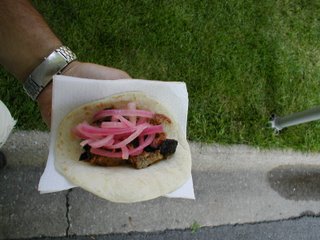
Repeat.
Notes: the Tacos were magnifico, and they where enjoyed by all the gritty Southsiders. The marinade only called for 1 tablespoon of salt, I’d maybe double that next time. The onions had an exquisite color but they needed a bit more sweet. Next time make sure you have enough charcoal.
Cheers.

